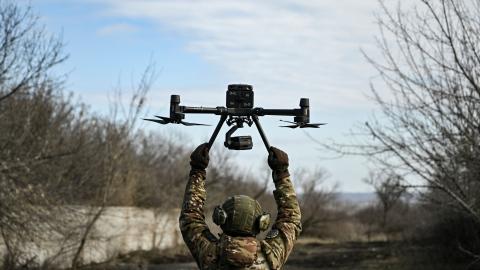This report first appeared as a part of Hudson's Re: Ukraine newsletter series. To subscribe, click here.
Below Hudson Senior Fellow Can Kasapoğlu offers a military situation report about the war in Ukraine.
1. Ukraine’s Tactical Drone Use Is Rapidly Progressing
For some time, the Ukrainian military has been getting greater bang for its buck out of its tactical drone warfare systems. Two factors have driven this breakthrough.
First, Ukraine is now pursuing a more valuable target set. Open-source military intelligence suggests that over recent weeks, Ukrainian loitering munitions have been preying on high-end Russian weapons systems, such as Tor-M2 and S-300V4 surface-to-air missiles (SAM), TOS-1 thermobaric multiple-launch rocket systems, and main battle tanks. At the same time, the Ukrainian military has been making greater use of cost-effective, low-tech methods, such as cheap rotary-wing unmanned aerial vehicles releasing thermobaric grenades into the open hatches of Russian land warfare platforms.
Second, Kyiv has upped its use of commercially available FPV (first-person view) drones with strip-on explosives. These out-of-the-box drone warfare assets are often married to quadcopters that provide real-time intelligence and target-acquisition data. Inspired by FPV drone racing sports, the weaponized FPV platforms offer a faster strike edge and more agile maneuverability, especially in cluttered terrain.
The war in Ukraine has marked a turning point for the military applications of drones, including the weaponization of commercially available platforms. The Ukrainian Armed Forces have led the way in the use of robotic warfare systems.
2. Russia Ramps Up Its Missile Warfare Efforts; Ukraine’s Interception Rates Lag
On March 9, 2023, the Armed Forces of the Russian Federation conducted one of the largest drone and missile salvos of the year. According to the Ukrainian General Staff, the strike package consisted of Kinzhal aero-ballistic missiles, Kalibr cruise missiles launched from naval platforms, modified Kh-22 anti-ship missiles, air-to-ground cruise missiles unleashed by Russian Aerospace Forces, S-300 SAM missiles used in land-attack roles, and Iran-manufactured Shahed-136 and Shahed-131 loitering munitions.
Worrisomely, the Ukrainian air and missile defenses’ interception rates proved lower than usual. Of some 80 missiles, the Ukrainian Armed Forces were able to intercept only 34; of eight Iran-made loitering munitions, only four were downed.
Several factors can explain the Ukrainian air and missile defenses’ relative underperformance. The strike package included six Kinzhal aero-ballistic missiles, far more than in previous attacks. Because of the Kinzhal aero-ballistic missile’s high-end hypersonic features, Ukraine lacks a missile defense system capable of intercepting it. Second, the land-attack S-300 missiles used in the attack follow a quasi-ballistic trajectory that frustrates traditional air- and missile-defense architecture. The Kh-22 anti-ship missile, originally designed to target aircraft carriers, combines the hard-to-detect flight characteristics of a cruise missile, supersonic speed, and a highly destructive warhead. Ukraine had little chance against such a lethal combination.
The Ukrainian Armed Forces’ 50 percent interception rate against the Iran-made loitering munitions—far less successful than usual—proved worrisome as well. The Shahed-131 has a new engine, and the Russia-Iran alliance has been working on upgrading the Shahed-136 baseline. It remains to be seen if these capability development efforts led to lower interception performance.
3. Bakhmut Update: “A River Runs Through It”
Bakhmut is the most dynamic front of the ongoing war, testing open-source defense intelligence to its limits. The British Ministry of Defense’s assessments suggest that the Bakhmutka River now marks the front line between the warring parties. It seems that warfare—a traditional human activity with ancient roots—is still the prisoner of geography and will remain so in the foreseeable future. Rivers still mark the natural lines of contact in war, as in Kherson and Bakhmut.
Nevertheless, one should not confuse the Bakhmutka River with the Dnieper line of contact in the south, which is hundreds of kilometers long. The Dnieper front line has sequestered the Ukrainian and Russian combat formations to their respective western and eastern banks since the Ukrainian military’s Kherson offensive in the fall of 2022. The situation in Bakhmut, however, is a textbook example of battleground dynamism.
At the time of writing, Russian advances continue slowly but steadily, enjoying a favorable battlefield geometry. Wagner units backed by the Russian military are fighting their way into the tactical depth of the town. Unless the Ukrainian General Staff radically alters the situation, it is a matter of when, not if, Russian forces will completely capture their objectives.
For a long time, the Western strategic community has been debating the cost-benefit calculus of holding Bakhmut at the expense of many Ukrainian casualties. Previous editions of this report have communicated our findings, concluding that a prolonged Ukrainian defensive in Bakhmut has started to cause burdensome attrition that could potentially jeopardize Ukraine’s long-awaited spring offensive. Once the Ukrainian military fully operates its incoming supply of Western main battle tanks and infantry fighting vehicles, it would need every single battalion for a large-scale breakthrough in the south.
A zoom-out view of the broader battle picture flags an additional risk, too. After Bakhmut, Russia’s subsequent direction of attack will likely hit the Ukrainian lines of defense along the Sloviansk-Kramatorsk axis. The prospects of such a scenario cannot be divorced from current Russian attempts to re-invade Lyman following the successful Ukrainian counteroffensive there in October 2022.
While it often fails to attract adequate attention, the Ukrainian General Staff time and again reports Russian offensive activity in the direction of Lyman. Should a Russian takeover there follow the possible fall of Bakhmut, it would put flanking pressure on the Slovyansk-Kramatorsk axis from the northern and eastern frontiers. The situation in Lyman is nowhere near as problematic as that in Bakhmut. But if Bakhmut falls, it could become so.
4. The Ethnic Demographics of Russian Casualties
The British Ministry of Defense’s March 12 intelligence report highlighted the ethnic imbalance among the casualties in Vladimir Putin’s forces. According to London’s military briefing, casualties from eastern regions of the Russian Federation are 30 times higher than those from core ethnic-Russian cities like Moscow. Almost 75 percent of the fallen troops of Astrakhan, for example, were from the Turkic Kazakh and Tatar populations.
Ethnic fault lines within the Russian military have only widened since the invasion of Ukraine. Due to political, economic, and demographic drivers, the proportion of non-ethnic Russians in the armed forces has been on the rise. The partial mobilization announced in September 2022 has highlighted the inequalities between Russian core areas, such as Moscow and St. Petersburg, and the ethnic minority regions, such as Buryatia of eastern Siberia, which are now bearing the burden of the highly attritional war. Some scholars hailing from the Turkic-Asiatic communities of the Russian Federation have even called the Kremlin’s military policy a manifestation of historical Russian colonialism, which in their eyes not only plundered the regions’ vast resources but also their manpower.
In any authoritarian regime, ethnic and political fault lines are hard to fully understand: the world learns what has been going on only when the situation explodes unexpectedly. The contemporary Russian Federation is no different from other authoritarian states in this way. One can only begin to grasp the ethnic tensions sparked by the war in Ukraine—such as the Dagestan protests against mobilization and drafting—by examining telltale indicators like casualty rates.
One must wonder whether the North Caucasus will prove the Achilles’ heel of the Russian empire. Anti-Russia Chechen battalions fighting alongside the Ukrainian military and anti-war protests in Dagestan are not promising signs for Moscow.
















